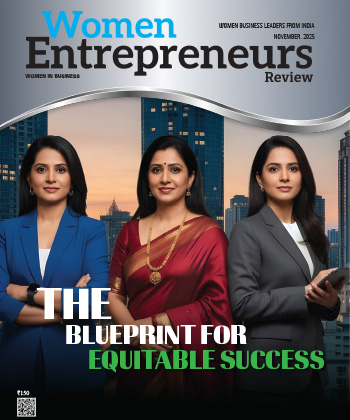
Redefining Project Leadership in the Age of AI & Agility
By: Swapna Ramarao, Centre of Excellence - Global Finance Business Lead, HSBC
Swapna Ramarao, with a strong foundation in banking operations and a passion for process improvement, Swapna transitioned into project management to enhance customer experience. A certified PMP, she emphasizes structured governance, documentation, and standardization while staying current with emerging trends like AI to drive continuous learning and relevance.
In an engaging interaction with Women Entrepreneurs Review Magazine, Swapna shares her insights on AI's impact on project management, balancing process optimization with customer adaptability, enhancing project governance, and the evolving role of project managers in the age of agile methodologies and AI-driven solutions.
How do you see AI reshaping project management, and what steps should organizations take to integrate AI effectively into their workflows without losing the human touch?
AI is revolutionizing project management, shifting it from a process-driven to an insight-driven function. By automating and predictively optimizing tasks such as scheduling, risk forecasting, and resource management, AI empowers project managers to prioritize leadership, drive innovation, and deepen stakeholder engagement. To effectively integrate AI, organizations should position it as an enabler rather than a replacement. Adopting a "human-in-the-loop" approach—where AI enhances project decision-making, but human oversight remains central—ensures organizational efficiency while maintaining a strong connection to people. Carefully blend automation and human interaction points. For instance, automate repetitive reporting but retain personal engagement for stakeholder management.
How do you assess the balance between optimizing internal systems and maintaining flexibility to adapt to customer demands in a constantly changing environment?
Internal systems should be designed to enable, not constrain, responsiveness. I focus on building agile, modular processes that prioritize outcomes over rigid procedures. Continuous feedback loops—from both internal teams and customers—help us fine-tune operations without losing sight of market needs. By embedding a culture of experimentation and empowerment, organizations can maintain operational excellence while remaining flexible. It’s important to view processes as living frameworks that evolve, ensuring we can quickly pivot, innovate, and deliver value as customer expectations shift.
Given the increasing emphasis on documentation and standardization in project management, what is the next frontier in enhancing project governance while fostering creativity and innovation?
In today’s banking environment, where regulatory compliance and risk management demand rigorous documentation and standardization, the next frontier in project governance lies in adaptive governance models. These models balance structure with flexibility by embedding agile principles into traditional frameworks. Leveraging AI-driven project analytics, automated compliance checks, and dynamic risk management tools will help ensure governance remains robust while freeing up teams to focus on creativity and innovation. Additionally, fostering a culture of psychological safety—where team members feel empowered to challenge norms and propose new ideas—will be critical. Ultimately, the future of project governance will not just be about controlling processes but about enabling smarter decision-making, faster adaptation, and human-centric innovation, all while maintaining the highest standards expected in the sector.
How do you see the role of project managers evolving as businesses continue to embrace agile methodologies and AI-driven solutions, especially in terms of leadership and decision-making?
Project managers are becoming enablers and facilitators of change rather than controllers of process. Leadership is shifting toward servant leadership models, where empowering cross-functional teams, fostering collaboration, and driving a shared vision become critical. With AI automating data gathering and offering predictive insights, human judgment will be key, especially in areas like risk evaluation, stakeholder management, and innovation prioritization. Project managers will need to combine emotional intelligence, business acumen, and technology fluency to make faster, smarter decisions in a rapidly changing environment.
How can organizations cultivate a culture of continuous learning and adaptation among their project management teams to stay competitive in a fast-paced industry?
Organizations must embed learning into the flow of work rather than treating it as a separate activity. Key strategies include: 1. Promote a growth mindset: Encourage project managers to view change and emerging trends as opportunities rather than threats. 2. Invest in upskilling and reskilling: Provide access to certifications, AI and agile training, leadership programs, and microlearning platforms that help PMs stay current with evolving methodologies. 3. Create safe environments for innovation: Build a culture where it’s safe to fail fast and learn. 4. Leverage communities of practice: Set up internal forums or guilds where PMs can share knowledge, best practices, and lessons learned in real time.
What are some of the overlooked challenges when implementing AI and automation in project management? How can businesses proactively address them to ensure long-term success?
Some overlooked challenges include:
Resistance to Change: Without strong change management and transparent communication, adoption can stall.
Data quality issues: Inconsistent, incomplete, or biased project data can lead to poor automation outcomes.
Skill gaps: Project managers need new competencies — not just technical skills, but also critical thinking, data literacy, and AI governance awareness.
These challenges can be addressed by leading with empathy and inclusion; investing in robust data practices; upskilling the workforce; and encouraging a culture of collaboration. Make AI a partner, not a threat, by promoting open dialogues about its role and potential. Ultimately, balancing technological innovation with human-centric leadership is what ensures sustainable, long-term success.






